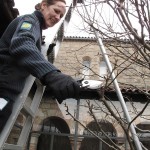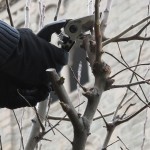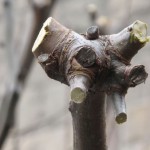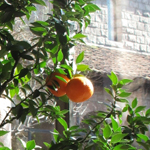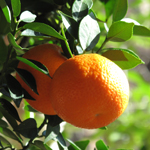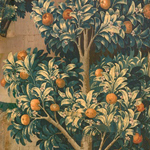Archive for February, 2011
Friday, February 25, 2011
A medieval technique of hard pruning, known as pollarding, is used on the four crab apple trees in Cuxa Cloister garden to control the height of the trees and the spread of their canopies. The pruning is done in late winter, while the trees are still dormant.
Above:??Frances Reidy, our arborist, cutting last spring’s growth back to the same “head” as the previous spring’s. This successive hard pruning produces the “knuckles” of tissue characteristic of pollarded trees. This is the third year in which the technique has been applied; the knuckles at the head of the branches will become more pronounced as the pollard matures.
Read more »
Tags: ash, crab apple, Cuxa Garden, pollarding, willow
Posted in Gardening at The Cloisters, Medieval Agriculture | Comments (6)
Friday, February 18, 2011
Above: Both bitter and sweet oranges were introduced into Europe from Asia, but the bitter species preceded the sweet species by??five centuries. The bitter Citrus aurantium var. myrtifolia, a sport, or spontaneous mutation, of the medieval species suitable for pot culture, overwinters on the sunny side of the Cuxa Cloister arcade. The fruit of Citrus aurantium is economically important as a flavoring, although it is too bitter to eat out of hand. The sweet orange, Citrus sinensis, depicted in The Unicorn is Found, would have been introduced only about fifty years before the tapestry was designed.
The bitter orange, Citrus aurantium, spread from its native China to India in ancient times. The orange is mentioned in an early Ayurvedic medical text, Charaka Samhita. According to food historian Alan Davidson, the Sanskrit “naranga” became naranj in Arabic, narantsion in post-classical Greek, and aurantium in Late Latin. Albertus Magnus, the first medieval writer to describe the bitter orange, called the fruit “arangus,” from which the Italian arancia and the French and English “orange” all derive. Read more »
Tags: Ayurvedic, Charaka Samhita, Citrus aurantium, Citrus sinensis, limonaia, myrtifolia, orange, orangerie, stomachic, Tacuinum Sanitatis
Posted in Gardening at The Cloisters, Plants in Medieval Art | Comments (2)
Thursday, February 10, 2011
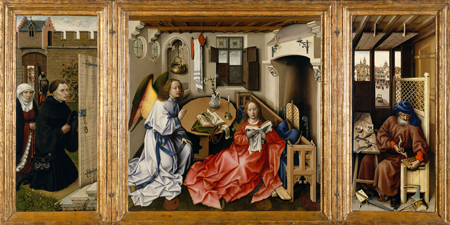
Robert Campin and Workshop (South Netherlandish, Tournai, ca. 1375???1444). Triptych with the Annunciation, known as the “Merode Altarpiece,” ca. 1427???32. Made in Tournai, South Netherlands. Oil on oak. The Metropolitan Museum of Art, New York, The Cloisters Collection, 1956 (56.70a???c). See Google Art Project for an in-depth look at this work.
A great many things have changed during the twenty years that I’ve been working at The Cloisters, but its special atmosphere remains constant. One of the most unique aspects of the Museum is the way in which the gardens are integrated into the collection. From the Museum’s inception, the curators envisioned the artwork and gardens as a whole, where the plants were not merely aesthetic elements, but also of great educational value. Many of the galleries either open directly onto or provide views into one of the three interior gardens (see floor plan). This arrangement encourages visitors to experience the gardens as part of medieval culture, to make connections between the plants and the objects, and to understand both within the historical context presented in the galleries. Read more »
Tags: Antonites, Bellis perennis, Claviceps purpurea, corn poppy, Cuxa Garden, English daisy, ergotism, fungus, Galen, grain, hermit, ignis sacer, Isenheim, mandrake, Matthias Gr??newald, monasticism, Niclaus of Haguenau, plantain, poppy, sage, Saint Anthony Abbott, Saint Anthony's Fire, Saint Vinage, Tau cross, verbena
Posted in Gardening at The Cloisters, Plants in Medieval Art | Comments (1)
Saturday, February 5, 2011

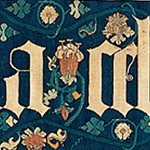
Above: Two details from a tapestry-woven praetexta (Germany, Cologne, about 1450-75) currently on display at The Cloisters. The??flower shown at the center??of the detail on the??left is a fantasy.??The detail on the??right??shows a botanically unmistakable lily;?? a strawberry, embellished with a fanciful??and botanically incorrect??element at the??bottom of the fruit,??appears just below and to the left of the lily.?? See the full image.
A plant in a medieval work of art need not be naturalistically depicted to be recognizable. Even a very stylized representation may have characteristics so distinctive that it can be given a botanical identity with complete confidence. Read more »
Tags: achene, berry, Fragaria vesca, hull, lily, Narcissus pseudo-narcissus, seeds, strawberry
Posted in Plants in Medieval Art, Useful Plants | Comments (0)
